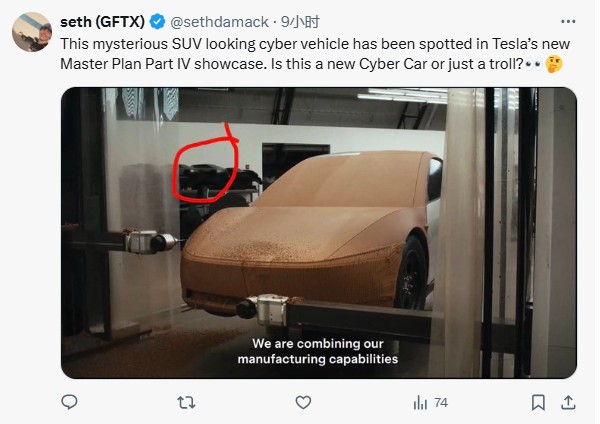
Tesla's "Grand Plan 4" Released: Massively Integrating AI into the Physical World to Achieve a "Sustainable Abundance" Society

特斯拉的最新藍圖將其戰略重心從電動汽車全面轉向人工智能與機器人領域,旨在通過 AI 與物理世界的深度融合實現 “可持續富足” 的社會願景。馬斯克稱,未來特斯拉約 80% 的價值將來自機器人 Optimus。但批評者指責其僅為 “AI 空談”,掩蓋了特斯拉在銷量下滑和前序計劃未完成等方面的現實困境。
特斯拉的未來,是繼續引領電動車革命,還是成為一家人工智能公司?其最新發布的宏偉藍圖給出了答案,卻也引發了更多爭議與質疑聲。
9 月 2 日,特斯拉官方在 X 平台上正式發佈 “大師計劃第四篇章”(Master Plan Part IV),全面改寫公司的宏大敍事。它將公司的發展重心前所未有地從電動汽車和能源全面轉向人工智能和機器人領域,旨在通過大規模地將 AI 融入物理世界,實現一個 “可持續富足” 的社會。
該計劃建立在特斯拉過去近二十年在電動汽車、能源產品和人形機器人方面的積累之上,並提出了 “增長是無限的”、“創新消除限制” 等五大指導原則宣告公司正進入一個前所未有的增長時期,致力於通過自動駕駛、人形機器人等技術加速全球繁榮。
對於這番宏大目標,特斯拉 CEO 馬斯克給出了一個更具體的數值:80%。他説道:
未來,特斯拉約 80% 的價值將來自機器人 Optimus。

馬斯克曾多次為此次 “宏圖計劃 4” 做預熱,去年他就自信地表示:這將是史詩般的。然而,這份綱領性文件因缺乏具體執行路徑,正面臨着 “空談 AI” 的尖鋭批評。
媒體 Electrek 的評論員 Fred Lambert 稱,該計劃 “不過是一堆模糊的 AI 承諾的大雜燴”,甚至諷刺其人形機器人 “連爆米花都端不好”。相較於馬斯克此前清晰、可執行的大師計劃,第四篇章更像是 “給特斯拉股東的鴉片”,旨在讓他們沉迷於 AI 股票 “無限增長” 的幻想,而缺乏實際支撐。
宏大願景:AI 驅動的 “可持續富足”
特斯拉在 “大師計劃第四篇章” 中,將公司的終極目標定義為 “在不妥協的情況下實現不受約束的可持續性”。
文件開篇即強調,特斯拉正在構建將人工智能引入物理世界的產品和服務,並已為此進行了近二十年的基礎性工作,涵蓋電動汽車、能源產品和人形機器人。
該計劃提出五大指導原則:
-
增長是無限的:技術創新可以解決資源短缺問題,創造更多經濟機會。
-
創新消除限制:如同特斯拉通過創新打破電池技術瓶頸一樣,持續的創新可以克服看似不可能的障礙。
-
技術解決實際問題:自動駕駛汽車和 Optimus 機器人等產品旨在解決交通安全、效率以及重複性或危險性勞動等現實世界的問題。
-
自動駕駛必須惠及全人類:其發展和應用應以提升人類福祉為核心。
-
更廣泛的普及推動更大的增長:以可負擔的價格大規模提供先進技術產品,是構建繁榮社會的必要條件。
特斯拉宣稱,公司正處於 “前所未有的增長” 革命時期,這將是 “特斯拉和全人類的一次飛躍”,最終目標是建立一個 “可持續富足的世界”。以下是 “Tesla 宏偉藍圖第四篇章” 全文:
Tesla 宏偉藍圖第四篇章
引言
自特斯拉成立以來,我們宏偉藍圖的每一個版本都專注於我們的北極星:在不妥協的情況下實現無拘無束的可持續發展。
人類是工具製造者。在特斯拉,我們大規模、低成本地製造實體產品,目標是讓每個人的生活變得更好。
隨着人工智能(AI)技術的影響力越來越大,宏偉藍圖第四篇章中提出的使命也就不足為奇了。
特斯拉故事的下一個篇章將幫助我們創造一個我們才剛剛開始想象的世界,並以我們尚未見過的規模來實現。我們正在構建將人工智能帶入物理世界的產品和服務。
在過去的近二十年裏,我們通過開發電動汽車、能源產品和人形機器人,為這場技術復興奠定了基礎,併為此不懈努力。
現在,我們將製造能力與自動駕駛技術相結合,提供新的產品和服務,以加速全球繁榮和人類福祉,實現人人共享的經濟增長。我們正在大規模統一硬件和軟件,並在此過程中創造一個更安全、更清潔、更宜居的世界。
這就是可持續的富足。
指導原則
增長是無限的。
一個領域的增長不一定導致另一個領域的衰退。資源短缺可以通過改進技術、更大的創新和新思想來解決。
賦予我們驅動機器能力的技術帶來了工業革命,拓寬了我們的經濟格局,為所有人創造了更多機會。半導體和互聯網等突破性發明擴大——而不是減少——了人類體驗各個方面的社會和經濟機會,從創造更多就業機會到提供更大的信息獲取,再到實現更深層次的人際連接。
我們渴望超越被認為是可實現的界限,這將促進真正可持續富足所需的增長。
創新消除限制。
幾個世紀以來,人類主要的交通工具是馬匹。然後,在過去的五十多年裏,由化石燃料驅動的內燃機汽車成為標準和預期的交通方式。電池可以廉價生產並達到足夠大的規模以使交通行業擺脱化石燃料的想法似乎是徒勞的——直到特斯拉率先開闢了前進的道路。
通過持續創新,我們克服了電池開發的技術限制,並建立了一個由可再生資源驅動的行業。
技術解決實際問題。
源於向可持續富足加速發展的產品和服務將通過解決現實世界的問題來推動人類進步。為了進一步加速我們的創新,我們製造的每一款產品都比上一款更高效、更可持續。
太陽能發電和大規模電池儲能正在提高我們社區清潔電力的可用性和可靠性——而且價格更低,也更可持續。
自動駕駛汽車有能力顯著提高交通的可負擔性、可用性和安全性,同時減少污染,特別是在我們日益密集的全球城市中。
Optimus——我們的人形機器人——不僅改變了對勞動力本身的看法,還改變了其可用性和能力。特別單調或危險的工作和任務現在可以通過其他方式完成。通過這種方式,Optimus 的使命是讓人們有更多時間去做他們喜歡的事情。
自主性必須造福全人類。
我們在特斯拉制造的工具幫助我們生產推動人類繁榮的產品。
我們如何開發和使用自主技術——以及它為我們帶來的新能力——應該以其提升人類狀況的能力為指導。通過我們的自主技術,讓所有人的日常生活變得更好、更安全,一直是並將繼續是我們的重點。
更大的獲取帶來更大的增長。
要建設一個繁榮、不受限制的社會,就需要製造價格合理、規模化供應的高科技產品。它有助於進一步民主化社會,同時提高每個人的生活質量。精英管理的標誌是創造機會,使每個人都能運用自己的技能去實現他們所想象的一切。
每個人都應該獲得這些機會,技術進步可以幫助確保我們每個人都能最大化利用我們最有限的資源:時間。
我們正在加速世界向可持續富足的轉型。
我們必須明確一點:這一挑戰將極其難以克服。消除稀缺將需要不懈和精湛的執行。有些人會認為它是不可能的。許多其他人會嘲笑我們在此過程中不可避免遇到的每一個障礙和挫折。但一旦我們克服了這一挑戰,我們的批評者就會明白,他們曾經認為不可能的事情確實是可能的。這對我們來説沒關係,因為最重要的是,我們共同為子孫後代創造一個可持續的、真正富足的未來。
所有有價值的旅程都是漫長的。它們都始於第一步。
我們的第一步是製造一款激動人心的跑車——Roadster。然後我們利用這些利潤資助了更實惠但同樣激動人心的產品——Model S 和 Model X——的開發和生產。然後我們重複了這個過程,帶來了 Model 3 和 Model Y,並持續前進。
這個過程需要我們邁出許多步,有些是小步,有些是大步。但最終每一次勝利都帶來了另一次勝利,即使我們遭遇失敗,我們也能夠繼續積累動力。我們的動力使我們能夠建立一個完全集成的可持續產品生態系統,從交通到能源生成、電池存儲和機器人技術。
今天,我們正處於一個革命性時期的邊緣,準備迎接前所未有的增長。而這一次,它不會是單一步驟,而是特斯拉和全人類的飛躍。我們將開發的工具將幫助我們構建我們一直夢想的世界——一個可持續富足的世界——通過大規模地為所有人重新定義勞動力、交通和能源的基本組成部分。
褒貶不一:是 AI 帝國,還是 AI 幻想?
對於特斯拉這一宏大願景,市場褒貶不一。
有網友稱,這聽起來特斯拉正在重新定義大規模自動駕駛的框架。藍圖 4 是迄今為止公佈的所有內容的擴展版。

還有眼尖的網友在藍圖 4 的宣傳片中發現一個有趣的細節,一個神秘的車型出現。這是特斯拉要造的全新賽博車?

但批評的聲音同樣尖鋭,媒體 Electrek 的評論員 Fred Lambert 説道:
特斯拉終於發佈了《宏圖計劃第四篇章》,但這不過是一堆關於其人形機器人的 AI 承諾大雜燴——這機器人甚至連爆米花都端不好。一年多來,特斯拉 CEO 埃隆·馬斯克一直在吊人胃口,預告公司將發佈《宏圖計劃第四篇章》。自 2006 年起,馬斯克持續為特斯拉發佈 “秘密宏圖”,以闡述公司更廣闊的使命和產品路線圖。馬斯克本人最近承認,2016 年發佈的《宏圖計劃第二篇章》甚至至今都尚未完成。他認為 “明年” 能實現,但這種話我們早已聽過。
特斯拉作為一家公司已迷失方向。這就是一堆烏托邦式的胡言亂語,滿是 GrokAI 都能輕易寫出的 AI“豐裕” 流行詞。埃隆的前兩個宏圖計劃直截了當,具有清晰、可操作的步驟和明確的產品路線圖。相比之下,這份計劃是提供給特斯拉股東的鴉片,讓他們獲取作為 AI 股 “無限增長” 潛力的快感。這不是真的。
人人都能看到一款能自主執行有用任務且價格親民的人形機器人的價值。你不需要向人們推銷圍繞它構建的怪異烏托邦未來。先從證明你能造出這樣的機器人開始。我們至今未見任何證據。我知道我可能聽起來像個黑子,但我不在乎。特斯拉並不是一家即將交付 “可持續豐裕” 未來的公司。
特斯拉是一家曾創造奇蹟、顯著加速世界向電動交通轉型的公司。然後,它的 CEO 瘋了。銷量開始下滑,盈利開始下降,為維持荒謬的股價,CEO 決定搭乘 AI 泡沫。僅此而已。
許多網友對特斯拉在 AI 領域的成功也持懷疑態度,認為馬斯克的管理風格和公司文化可能使其在招募頂尖 AI 人才方面面臨挑戰,遠不及 OpenAI、微軟、蘋果和亞馬遜等巨頭有吸引力。
他不太可能在 AI 領域取得成功,因為他是唯一領導這項努力的人。他的管理風格就是下達任務然後對工程師咆哮直到東西做出來。
人才招募競爭激烈,目前 Open AI、微軟、蘋果和亞馬遜都比為一個擁有威權政治觀點的反覆無常的自戀狂工作有吸引力得多。
還有網友問道:那麼特斯拉到底打算什麼時候完成宏圖計劃 [1]、[2] 或 [3] 呢?
2006 年的宏圖計劃 1:
1. 製造跑車。
2. 用賺到的錢製造價格親民的汽車。
3. 用賺到的錢製造更親民的汽車。
4. 在進行上述步驟的同時,提供零排放的發電選項。Roadster 算是完成了步驟 1。Model S 是豪華車,不算親民。Model 3 或許算親民,所以我們可以稱之為步驟 2。由於埃隆·馬斯克取消了 Model 2,沒有比 Model 3 更便宜的真正面向大眾市場的車型了,所以步驟 3 沒完成。他們沒有提供有實際意義的太陽能發電方案,所以步驟 4 也沒完成。
2016 年的宏圖計劃 2:
1. 創造與儲能電池無縫整合的驚人太陽能屋頂。
2. 擴展電動汽車產品線,覆蓋所有主要細分市場。
3. 通過大規模車隊學習,開發出比人類手動駕駛安全 10 倍的自動駕駛能力。
4. 讓你的車在你不使用的時候為你賺錢。太陽能屋頂是個騙局,從未像 [4][5][6][7] 所展示的那樣成功過,所以步驟 1 沒完成。他們確實將電動汽車產品線擴展到了大多數最適於大眾市場的消費細分領域,所以樂觀的話我們可以稱之為完成了步驟 2。但如果我們把這理解為覆蓋所有主要細分市場(例如他們用 Semi 半掛卡車暗示的商業車輛領域),那麼步驟 2 就沒完成。他們的車輛不具備自動駕駛能力,甚至持續在基本、簡單的道路狀況下失敗 [8],所以步驟 3 沒完成。他們 doubly(更加)無法像向投資者和消費者承諾的那樣,讓你在不用車時通過 robotaxi(機器人出租車)服務賺錢,所以步驟 4 也沒完成。
2023 年的宏圖計劃 3:
1. 用可再生能源為現有電網重新供電
2. 轉向電動汽車
3. 在住宅、商業和工業領域轉向熱泵
4. 實現高温熱輸送和氫氣生產的電氣化
5. 為飛機和船隻提供可持續燃料
6. 製造可持續能源經濟這甚至算不上是特斯拉的計劃。它更像是某種公共政策分析/提案?除了電動汽車,他們甚至沒有實質性參與上述其他行業,並且在宏圖計劃 3 發佈後的兩年裏,也未展現出任何有意義的努力來進入這些行業。
所以,19 年過去了,他們在宏圖計劃 1 的 4 個步驟中失敗了 2 個。9 年過去了,他們在宏圖計劃 2 的 4 個步驟中失敗了 3 個。2 年過去了,他們在宏圖計劃 3 的 6 個步驟中甚至還沒開始 5 個。而現在,他們又搞出了這個所謂的宏圖計劃 4,甚至連一個連貫的計劃都算不上。至少宏圖計劃 1 和 2 還算是有可行性的計劃。而這個 ‘計劃’ 只是一篇冗長的營銷吹噓文章。





